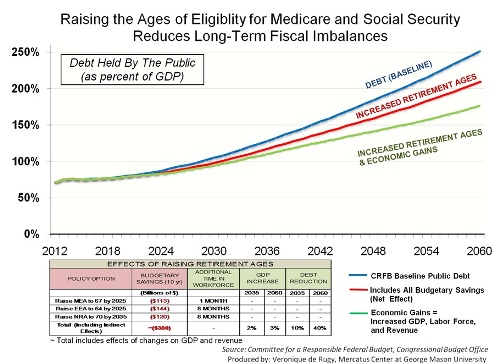- | Government Spending Government Spending
- | Data Visualizations Data Visualizations
- |
Raising Medicare and Social Security Eligibility Ages
This week’s chart considers the fiscal and economic effects of raising the ages of eligibility for Medicare and Social Security.
In this week’s chart, Mercatus Center Senior Research Fellow Veronique de Rugy considers the fiscal and economic effects of raising the ages of eligibility for Medicare and Social Security (SS). A recent report by the Congressional Budget Office (CBO) estimates the reductions to federal spending that result from revising the Medicare eligibility age (MEA), SS earliest eligibility age (EEA), and SS normal retirement age (NRA). This chart uses data from the Committee for a Responsible Federal Budget (CRFB) that uses CBO’s recent estimates to calculate out to 2060 the effects on U.S. public debt of raising eligibility ages.
Thechart plots U.S. public debt under three scenarios (expressed as a percentage of GDP). The blue line plots the baseline debt under current law; the red line plots debt with budgetary savings from simultaneously raising all three eligibility ages; and the green line plots the debt with budgetary savings and potential economic effects (further explained below) together.
The current age of eligibility for Medicare benefits is 65. This chart looks at the impact of gradually raising the age of eligibility for Medicare to 67 by 2025. CBO estimates, that this option would reduce federal spending by about $148 billion over ten years, and reduce the deficit by $113 billion.These savings account for the net effect of changes in federal spending on Medicaid, exchanges, federal retirees, and SS retirement. Unlike Medicare, with its single eligibility age, SS allows workers to receive a reduced retirement benefit as early as age 62. Raising the EEA to 64 by 2025 and NRA to 70 by 2035 will result in $264 billion in federal savings.
The long-term budget impact includes Medicare spending declining by 5 percent and SS spending declining by 13 percent. After a decade, CBO estimates that federal spending could be reduced by $380 billion (including effects of GDP growth and revenue increases). Even under the worst assumptions about the success of raising eligibility ages, debt will be reduced by about 10 percent of GDP by 2035 and 40 percent of GDP in 2060 (red line). After considering the economic gains from an increase in savings and investment, higher GDP, and the higher revenue that CBO estimates would occur as a result of these policies, reductions to the debt nearly double (green line).
Raising the eligibility age for Medicare and SS bolsters economic growth, encourages work, and promotes savings and investment. These positive effects could also result in higher federal revenue as wages and income grow.
As evidence from both CBO reports suggests, raising eligibility ages for Medicare and SS bolsters economic growth, encourages work, and promotes savings and investment. Thus, an important reason for raising eligibility ages is to make it easier to address the necessity of long-term entitlement reform. Reducing the number of beneficiaries and promoting self-reliance is likely to diminish resistance to further reforms.
Veronique de Rugy defends raising the age of retirement in New York Times Room for Debate.


